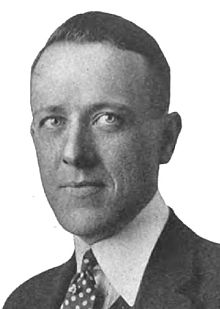Bud Fisher
| Harry Conway "Bud" Fisher | |
|---|---|

Fisher in 1915
|
|
| Born | Harry Conway Fisher April 3, 1885 Chicago, Illinois |
| Died | September 7, 1954 (aged 69) New York City |
| Nationality | American |
|
Notable works
|
Mutt and Jeff |
Harry Conway "Bud" Fisher (April 3, 1885 – September 7, 1954) was an American cartoonist who created Mutt and Jeff, the first successful daily comic strip in the United States.
Born in Chicago, Illinois, Fisher studied at the University of Chicago and then went to work as a journalist and sketch artist in the sports department of the San Francisco Chronicle. He introduced A. Mutt, the comic strip that would be better known by its later title, Mutt and Jeff, on November 15, 1907 on the sports pages of the San Francisco Chronicle. The featured character had previously appeared in sports cartoons by Fisher, but was unnamed. Fisher had approached his editor, John P. Young, about doing a regular strip as early as 1905, but was turned down. According to Fisher, Young told him, "It would take up too much room, and readers are used to reading down the page, and not horizontally."
During this time, newspaper cartoons appeared in a single-panel format. Fisher innovated by telling a cartoon gag in a sequence, or strip, of panels, creating the first American comic strip to successfully pioneer that since-common format. The concept of a newspaper strip featuring recurring characters in multiple panels on a six-day-a-week schedule actually had been created by Clare Briggs with A. Piker Clerk four years earlier, but that short-lived effort did not inspire further comics in a comic-strip format. As comics historian Don Markstein explained,
Fisher's comic strip was very similar to A. Piker Clerk, which cartoonist Clare Briggs ... had done in the very same daily format for The Chicago American in 1903. But tho Fisher was born in Chicago, it's unknown whether or not he ever saw the Briggs strip, so let's give him the benefit of the doubt and say he had an idea. Despite the Briggs primacy, A. Mutt is considered the first daily strip because it's the one that sparked a trend in that direction, which continues to this day.
...
Wikipedia
